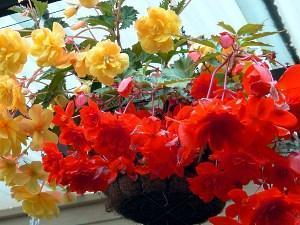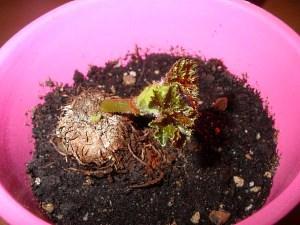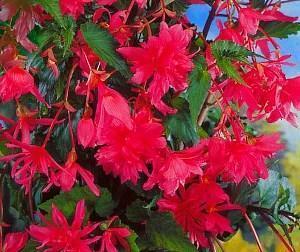Ampel begonias - cultivation, use, reproduction
 Ampel begonia has recently become very popular. She certainly deserves such recognition. It is one of the most attractive indoor plants. Everything deserves praise: delicate, bright asymmetrical leaves, beautiful bush shape, splendor of flowering, a variety of shapes and colors of flowers. In addition, the beauty is unpretentious. Even an inexperienced florist will cope with caring for an ampelous begonia if he knows the rules for growing this plant.
Ampel begonia has recently become very popular. She certainly deserves such recognition. It is one of the most attractive indoor plants. Everything deserves praise: delicate, bright asymmetrical leaves, beautiful bush shape, splendor of flowering, a variety of shapes and colors of flowers. In addition, the beauty is unpretentious. Even an inexperienced florist will cope with caring for an ampelous begonia if he knows the rules for growing this plant.
Planting ampelous begonia
To grow a good specimen of ampelous tuberous begonia, you need to select healthy strong tubers for planting. It is worth buying tubers in the store, the diameter of which exceeds 3 cm.The exception is small-flowered varieties. Preference should be given to well-cleaned specimens, without stains and damage. The upper (concave) part of them should be tight. Bumps and irregularities are visible on it - these are the kidneys. Those tubers that have from three to seven buds are good.
Before planting, the tubers are kept with the lower, convex side on a damp cloth, sand or suitable soil in warm and light. At the same time, the planting material is sometimes sprayed with warm soft water and a weak Epin solution. You can plant them when tiny white roots appear on the convex part.

The prepared tubers are laid out with the convex side on a damp (but not wet) soil and the space around is covered, leaving the upper part free. In this case, the top should be located a couple of centimeters below the edge of the pot. Until sprouts appear, the tubers are not covered with soil to the top.
Planting ampelous begonias are kept in a warm, bright place. Watered very carefully, trying not to hit the tuber. When the third leaf blooms on the sprout, the tuber is completely covered with soil, but not deeply.
Care
 For successful cultivation, ampel begonias must be placed in a place where they will be illuminated by the sun before 11 and after 15 hours. These plants prefer an air temperature of about 18-20 degrees, but they can withstand lower temperatures. Watering is moderate, it is unacceptable to overmoisten the substrate, but overdrying is also excluded. It is undesirable for water to hit the tuber; it is better to water along the edge of the pot or into the pan.
For successful cultivation, ampel begonias must be placed in a place where they will be illuminated by the sun before 11 and after 15 hours. These plants prefer an air temperature of about 18-20 degrees, but they can withstand lower temperatures. Watering is moderate, it is unacceptable to overmoisten the substrate, but overdrying is also excluded. It is undesirable for water to hit the tuber; it is better to water along the edge of the pot or into the pan.
Fortified begonias, so that they grow quickly and bloom elegantly, you need to feed. At the beginning of growth, nitrogen fertilizer is used for rapid vegetation. During flowering, fertilizers are needed for beautifully flowering plants, containing little nitrogen and a lot of potassium and phosphorus. Occasionally, you can use fertilizers in a chelated form, which contain many trace elements (they are called vitamins for flowers). Begonias will be grateful if they are pampered with organics 1-2 times a year.
The general rule for fertilizing begonias is that the solution should be weaker than indicated in the instructions. This is due to the fact that begonias do not like salting the soil very much.
The rest of the care for ampel begonias is the same as for other flowers: removing dried leaves and flowers, spraying, observing the plant so as not to miss the appearance of pests. Before flowering, it is good to give begonias a warm shower.After it, it is better to keep the plant in the bathroom overnight so that the water droplets dry. In no case should you put a wet plant in the sun - burns will appear on the delicate leaves.
 On any begonias there are 2 types of flowers: Large and elegant (possibly double or semi-double) - male and small unpretentious - female. If the plant is bad, it sheds male buds and loses its decorative effect.
On any begonias there are 2 types of flowers: Large and elegant (possibly double or semi-double) - male and small unpretentious - female. If the plant is bad, it sheds male buds and loses its decorative effect.
If the begonia is not tuberous, then it does not have a pronounced rest period and its decorative effect lasts all winter. Tuberous begonia after flowering, the shoots gradually dry up and the plant goes into deep hibernation. Then the tubers are removed from the soil, thoroughly cleaned from the remnants of soil and shoots, and placed in dry peat for storage. Keep at a temperature of 5-12 degrees.
If sprouts appear on the tuber in winter, then it is immediately planted, without waiting for spring. Such a plant needs additional lighting, better with special phytolamps.
Reproduction
You can propagate ampelous begonia in the following ways:
- seeds,
- stem cuttings,
- dividing the tubers.
With stem cuttings, begonia multiplies quickly and easily, retaining all the characteristics of the variety. The main characteristics of the mother plant are also well preserved when dividing the tubers. To do this, take large old tubers, which have more than seven buds, and cut them from top to bottom into several segments with a very sharp knife. Each piece should have at least two buds. Sections are dried and the resulting tubers are planted in the usual way.
Begonia ampelous from seeds turns out to be strong and healthy too. Sowing and caring for sprouts is the same as for other plants with very small seeds.
Ampel begonias are used both for decoration of premises and for landscaping balconies, windows, terraces. There are many varieties of such plants, differing in diversity, beauty, long flowering. In addition, most modern varieties are resistant to rainfall on flowers.
There is a whole series of ampelous begonia varieties - "Chanson". These are excellent plants with semi-double and double flowers with a diameter of 6-8 cm. The shape of the flowers resembles a camellia. The length of shoots in begonias of this series is from 30 to 40 cm.
The most common varieties of the Chanson series:
- E051 (White F1),
- E052 (Yellow F1),
- E053 (Salmon F1),
- E762 (Pink F1),
- E054 (Copper F1),
- E055 (Bright red F1),
- E056 (Dark red F1),
- E058 (Vanilla yellow F1),
- E606 (F1 two-tone pink-white),
- E607 (F1 Bicolor Orange-Yellow).